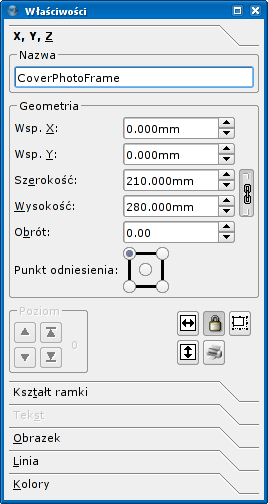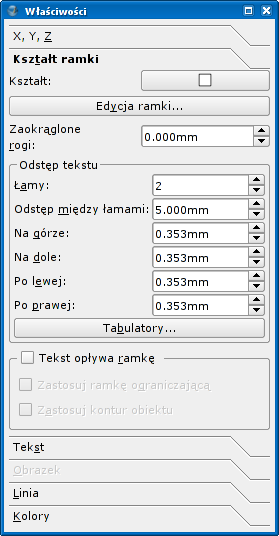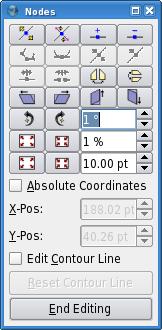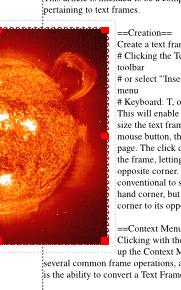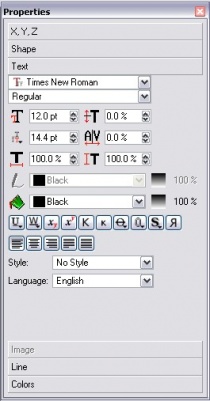Praca z ramkami tekstowymi: Difference between revisions
m (next section) |
|||
| Line 49: | Line 49: | ||
''Za pomocą myszy:'' | ''Za pomocą myszy:'' | ||
Kliknij ikonę [[Toolbars#Toolbar_Icons:_Modify_Objects| ''' | Kliknij ikonę [[Toolbars#Toolbar_Icons:_Modify_Objects| '''Obróć element''']] na pasku narzędzi (skrót klawiszowy: R), a następnie kliknij wewnątrz ramki i ciągle trzymając lewy klawisz myszy obróć o żądany kąt. | ||
''Za pomocą okna Właściwości:'' | ''Za pomocą okna Właściwości:'' | ||
Tak jak podczas zmiany rozmiaru i pozycji istnieją takie same możliwości zmiany parametrów obrotu ramki. Ponadto poniżej znajduje się ikona (wyglądająca jak para kostek) pozwalająca zmienić oś, wokół której następuje obrót -- może to być środek lub jeden z czterech rogów ramki. | |||
== | ==Kopiowanie ramek i inne operacje== | ||
Istnieje wiele sposobów na to, aby skopiować lub przesunąć ramki. | |||
# | # Na pewno znana jest Ci czynność kopiowania i wklejania (skróty klawiszowe: '''Ctrl+C''', '''Ctrl+V''') oraz wycinania i wklejania (skróty klawiszowe: '''Ctrl+X''', '''Ctrl+V''') -- dostępna także z menu '''Edycja''' oraz z menu kontekstowego (dostępnym poprzez kliknięcie prawym klawiszem myszki wewnątrz ramki). By wkleić na inną stronę, przejdź do żądanej strony, kliknij w nią, a następnie wklej -- ramka będzie umieszczona w tym samym miejscu co na oryginalnej stronie. | ||
# | # Jest także możliwość klonowania elementów (skrót klawiszowy: '''Ctrl+Alt+Shift+D''') '''Obiekt > Klonuj'''. Tworzy ona kopię, która jest przesunięta i umieszczona warstwę wyżej względem oryginału. | ||
# | # Znajdziesz też opcję wielokrotnego klonowania ('''Obiekt > Wielokrotne klonowanie''') która wyświetli okno pozwalające na utworzenie dowolnej ilości kopii z dowolnym przesunięciem. Ponadto możesz użyć tej opcji do jednokrotnego klonowania z wybranym przesunięciem. ''Uwaga: jeśli ustawisz przesunięcie w tym oknie, będzie ono wykorzystywane również przez '''Obiekt > Klonuj'''.'' | ||
# | # Możesz też przesunąć obiekt za pomocą <strong>prawego</strong> klawisza myszy. Po zwolnieniu przycisku zostanie wyświetlone okno dialogowe z zapytaniem czy obiekt ma zostać skopiowany, przesunięty lub czy operacja ma zostać anulowana. | ||
# | # Ponadto istnieje Biblioteka ('''Obiekt > Dodaj do biblioteki''' w wersji 1.3.x lub za pomocą menu kontekstowego). Utworzy to nazwaną kopię wybranej ramki wraz z jej zawartością w Bibliotece. Aby uzyskać do niej dostęp, wybierz z menu '''Okna > Biblioteka''' (w wersji 1.2.4 -- '''Narzędzia > Biblioteka''') -- zostanie wtedy wyświetlone okno, z którego możesz wkleić żądany obiekt na stronę. Zauważ, że możesz zapisać całą zawartość Biblioteki do pliku, który może zostać załadowany w innym dokumencie. | ||
Zapewne zauważysz, że ramki mogą znajdować się poza granicami strony i nadal podlegać kopiowaniu, klonowaniu i być manipulowane na rózne sposoby. Zostają również zapisywane wraz z dokumentem z zachowaniem ich aktualnych pozycji. Jednakże podczas generowania dokumentu PDF zostanie wyświetlone ostrzeżenie, że niektóre elementy nie znajdują się na stronie -- jeśli zostanie zignorowane, wygenerowany dokument PDF nie będzie zawierał tych elementów. Ponadto, szczególnie w przypadku dużych dokumentów, można łatwo stracić kontrolę nad elementami znajdującymi się poza stroną. | |||
==Entering/Editing Text in the Frame== | ==Entering/Editing Text in the Frame== | ||
Revision as of 17:41, 28 November 2006
- Linkownia
- Zrobione w Scribusie
- Gazety i czasopisma
- Polska lokalizacja Scribusa
- Darmowe polskie fonty
- Słowniczek pojęć z DTP
- Pierwsze kroki ze Scribusem
- Praca z ramkami tekstowymi
- Praca z ramkami graficznymi
- Praca ze stronami wzorcowymi
- Praca w Edytorze artykułów
- Tekst na krzywej
- Scribus w Ubuntu Linux
- Klik i Scribus działa
- Instalacja za pomocą Cmake
- Tworzenie spisu treści
- Formularze PDF
- Kolory dodatkowe
- Obrazek ze ścieżką odcięcia
- Instalacja profili ICC
- Dodawanie fontów
- Import grafik EPS
- Zawieszone spójniki
- Twój pierwszy artykuł
- Tworzenie hiperłączy
- Zarządzanie kolorami
- Skąd pobrać Scribusa?
- Podgląd wydruku nie działa
- Scribus dla MacOSX?
- Dodawanie fontów
- Scribus po polsku
- Type 1 i ligatury
- Automatyczne numery stron
- Interlinia w Scribusie
- Pierwsze kroki z DTP
- Skalowanie obrazka w ramce
- Export do PDF/X-3
- Ligatury i cyfry nautyczne?
- Pomoc w rozwoju Scribusa
- Przykładowe dokumenty
- Zgłaszanie błędów
- Słowniki dzielenia na sylaby
Tłumaczenie w toku!
Ten artykuł opisuje różne czynności związane z pracą z ramkami tekstowymi.
Tworzenie
Utwórz ramkę tekstową:
- klikając ikonę Utwórz ramkę tekstową na pasku narzędzi
- lub wybierając z menu opcję Wstaw > Ramka tekstowa
- skrótem klawiszowym: T lub Alt+W, T.
Pozwoli to na umiejscowienie i wybranie rozmiaru ramki za pomocą myszy. Aby tego dokonać przyciśnij lewy klawisz myszy, a następnie przeciągnij kursor po przekątnej strony. Przyciśnięcie klawisza myszy wyznacza jeden róg ramki, a puszczenie go wyznaczy róg znajdujący się na końcu przekątnej. Najbardziej typowym sposobem jest zaczęcie w lewym górnym rogu, jednakże można zacząć w dowolnym z nich.
Usuwanie
Usuń wybraną ramkę przyciskając klawisz Delete lub Ctrl+X.
Menu kontekstowe
Klikając prawym klawiszem myszki uzyskasz dostęp do menu kontekstowego, które zawiera najczęściej wykonywane operacje na ramkach, z których najważniejszą jest możliwość zamiany ramki tekstowej na inny typ ramki.
Pozycja i rozmiar
W tym punkcie zauważysz, że okno Właściwości jest niezastąpionym elementem podczas pracy ze Scribusem. Jeśli nie jest okno wyświetlone na ekranie, możesz otworzyć je poprzez skorzystanie z menu Okna > Właściwości. W wersji 1.2.4 nazywa się ono Narzędzia > Właściwości. Zakładka XYZ okna Właściwości pokazuje bardzo dokładne informacje o pozycji punktów X i Y lewego górnego rogu wybranej ramki - oznaczonej kreskowaną, czerwoną ramką. Ramka jest automatycznie wybierana w chwili jej utworzenia. Możesz odznaczyć ramkę klikając na obszar poza jej granicami, a zaznaczyć ponownie klikając w jej wnętrzu. Ramka musi zostać zaznaczona, aby mogła być modyfikowana lub przestawiana.
Zmiana rozmiaru/pozycji
Za pomocą myszy:
- Kliknij we wnętrzu ramki i przeciągnij na wybraną pozycję. Ramki mogą być umieszczane również poza stroną lub przesuwane z jednej strony na drugą (w zależności od wersji Scribusa).
- Kliknij i przeciągnij dowolny z czerwonych prostokątów umieszczonych na ramce by zmienić jej rozmiar.
Za pomocą okna Właściwości:
Istnieją 3 sposoby zmiany poszczególnych ustawień --
- edycja za pomocą klawiatury
- klikając na strzałkach w górę lub w dół umieszczonych na prawo od każdej wartości. Naciskając klawisze kursorów na klawiaturze uzyskasz ten sam efekt.
- używając rolki myszy -- zazwyczaj ustawienie kursora nad polem w zupełności wystarcza, jeśli nie kliknij w nie najpierw
Zauważ że dla drugiego i trzeciego sposobu, równoczesne przytrzymanie klawiszy Ctrl, Shift lub Ctrl+Shift (działa również dla klawiszy kursorów) możesz wybrać, które miejsce po przecinku ma zostać zmienione. Dodatkowo używając okna Właściwości, wysokość i szerokość są domyślne ze sobą połączone, lecz wystarczy kliknięcie na ikonę łańcucha by je rozłączyć.
Dodatkowe informacje
- Wybranie z menu pozycji Strona > Wyrównaj do linii pomocniczych (w 1.2.4: Widok > Wyrównaj do linii pomocniczych) spowoduje przyciąganie ramki do linii pomocniczych na stronie. Widok > Wyświetlaj linie pomocnicze wyświetla je na ekranie. (Tak jak siatka, linie pomocnicze nigdy nie zostaną wydrukowane ani nie staną się częścią pliku PDF.). Jeśli chcesz zmienić lub dodać nowe linie pomocnicze, skorzystaj z menu Strona > Zarządzaj liniami pomocniczymi lub Plik > Konfiguracja > Linie pomocnicze.
Obracanie
Za pomocą myszy:
Kliknij ikonę Obróć element na pasku narzędzi (skrót klawiszowy: R), a następnie kliknij wewnątrz ramki i ciągle trzymając lewy klawisz myszy obróć o żądany kąt.
Za pomocą okna Właściwości:
Tak jak podczas zmiany rozmiaru i pozycji istnieją takie same możliwości zmiany parametrów obrotu ramki. Ponadto poniżej znajduje się ikona (wyglądająca jak para kostek) pozwalająca zmienić oś, wokół której następuje obrót -- może to być środek lub jeden z czterech rogów ramki.
Kopiowanie ramek i inne operacje
Istnieje wiele sposobów na to, aby skopiować lub przesunąć ramki.
- Na pewno znana jest Ci czynność kopiowania i wklejania (skróty klawiszowe: Ctrl+C, Ctrl+V) oraz wycinania i wklejania (skróty klawiszowe: Ctrl+X, Ctrl+V) -- dostępna także z menu Edycja oraz z menu kontekstowego (dostępnym poprzez kliknięcie prawym klawiszem myszki wewnątrz ramki). By wkleić na inną stronę, przejdź do żądanej strony, kliknij w nią, a następnie wklej -- ramka będzie umieszczona w tym samym miejscu co na oryginalnej stronie.
- Jest także możliwość klonowania elementów (skrót klawiszowy: Ctrl+Alt+Shift+D) Obiekt > Klonuj. Tworzy ona kopię, która jest przesunięta i umieszczona warstwę wyżej względem oryginału.
- Znajdziesz też opcję wielokrotnego klonowania (Obiekt > Wielokrotne klonowanie) która wyświetli okno pozwalające na utworzenie dowolnej ilości kopii z dowolnym przesunięciem. Ponadto możesz użyć tej opcji do jednokrotnego klonowania z wybranym przesunięciem. Uwaga: jeśli ustawisz przesunięcie w tym oknie, będzie ono wykorzystywane również przez Obiekt > Klonuj.
- Możesz też przesunąć obiekt za pomocą prawego klawisza myszy. Po zwolnieniu przycisku zostanie wyświetlone okno dialogowe z zapytaniem czy obiekt ma zostać skopiowany, przesunięty lub czy operacja ma zostać anulowana.
- Ponadto istnieje Biblioteka (Obiekt > Dodaj do biblioteki w wersji 1.3.x lub za pomocą menu kontekstowego). Utworzy to nazwaną kopię wybranej ramki wraz z jej zawartością w Bibliotece. Aby uzyskać do niej dostęp, wybierz z menu Okna > Biblioteka (w wersji 1.2.4 -- Narzędzia > Biblioteka) -- zostanie wtedy wyświetlone okno, z którego możesz wkleić żądany obiekt na stronę. Zauważ, że możesz zapisać całą zawartość Biblioteki do pliku, który może zostać załadowany w innym dokumencie.
Zapewne zauważysz, że ramki mogą znajdować się poza granicami strony i nadal podlegać kopiowaniu, klonowaniu i być manipulowane na rózne sposoby. Zostają również zapisywane wraz z dokumentem z zachowaniem ich aktualnych pozycji. Jednakże podczas generowania dokumentu PDF zostanie wyświetlone ostrzeżenie, że niektóre elementy nie znajdują się na stronie -- jeśli zostanie zignorowane, wygenerowany dokument PDF nie będzie zawierał tych elementów. Ponadto, szczególnie w przypadku dużych dokumentów, można łatwo stracić kontrolę nad elementami znajdującymi się poza stroną.
Entering/Editing Text in the Frame
Story Editor
With a text frame selected, click the Story Editor icon on the toolbar (keyboard: Ctrl+Y), or Menu item Edit > Edit Text...; this is also available in the Context Menu (right-click in frame). The Story Editor is the most efficient way to manually enter text. The text will display with the correct font color, but the font face and spacing will not be reflected in the Story Editor's display. If the font color is similar to the background color in Story Editor, you may change the background color as desired: Story Editor menu Settings > Background....
The many features of Story Editor will be covered in detail elsewhere (also see Properties: Text Tab below - layout is different but features are the same). For this brief introduction, note that a large array of text features are completely under your control in Story Editor, including font face, color, spacing, kerning, justification, and more. Note that changing a setting will only modify text that you have selected (highlighted) and any subsequently entered text.
Take the time to learn how to create and use Styles, which will save time when you are repetitively using a font with a specific set of features.
Editing from the main page
Click the Edit Contents of Frame icon on the toolbar (keyboard: E). When you click inside the frame, you will see a blinking vertical cursor where you may add or edit text. You may also select (highlight) text and change the highlighted text features in Properties > Text. As you can see the choices are analogous to those in the Story Editor.
Editing All the text in the frame
If not already selected, click the Select item icon on the toolbar (keyboard: C | note that if you are in Edit Contents of Frame mode, pressing C will enter text in the frame). Now select the frame whose text you wish to edit. At this point if you make changes in Properties: Text, all text in the frame will be modified.
Special Characters, Foreign Language Accented Characters
There is the potential ability to insert foreign language accented characters, special symbols not found on the keyboard, typographic symbols (such as typographic quotation marks, em dash, en dash, variably sized spaces, for example), and ligatures. This capability can be found either in the main menu or Story Editor menu under Insert > Glyph, Insert > Character, Insert > Quote, Insert > Spaces & Breaks, and Insert > Ligature.
- If your special character fails to display, this most often means that it is not available in your chosen font. Just because it shows in Story Editor does not mean it will show on the page.
- Also see Typography.
Loading Text from a File
Load text from a file from the Context Menu (right click in frame) > Get Text, or from the menu File > Import > Get Text. You may also Append Text (Get Text will replace whatever is already in the frame). You may also load a file into Story Editor.
There are also the special files of "lorem ipsum" text, that can most easily be accessed from the Context Menu (right-click in frame), under Sample Text (from Menu: Insert > Sample Text). Scribus has this in several language versions, in addition to Latin.
Linking One Frame to Another
Text may be continued from one frame to another, on the same page or different pages.
First make sure the first frame is selected, then click the Link Text Frames icon on the toolbar (keyboard: N), then click the second frame -- that's it. If you have a third or more frames to also link, continue clicking to continue linking further frames. Remember that the links go in the order that you click from one to the next.
Note that frames can be linked before or after they have any content.
Unlink Text Frames is operationally similar -- click the first frame, then the Unlink icon, then the frames to unlink.
Levels & Layers
Frames in general, not just text frames, represent a two-dimensional space that you manipulate and move around your workspace, much like a small note you can attach and detach. Like small physical notes, they are laid down, one by one, on the page, new ones on a layer over the previous ones. The small box labeled Level in the XYZ tab of Properties allows you to move the selected frame up or down layers; the arrows with bars will move all the way to the top or bottom. Since the background of your frame may be opaque or transparent, the level the frame is at will affect how much of the frame can be visible in relationship to other overlapping or underlying frames.
XYZ Tab: The Rest
The remaining buttons in the XYZ tab do the following:
- Flip the selected frame horizontally or vertically
- Lock a frame in place. Everything about your frame is locked -- size, position, contents. Copying and pasting a locked frame may produce unexpected results.
- Lock the size of the frame only. Note that the editing tabs disappear from the corners and sides.
- Enable/disable printing of the frame. Why? You may want to have a frame on the page that's a message to yourself or someone else, yet not be part of the printed finished work. Or the frame may just be a space-saver for some other purpose.
Properties: Shape Tab
Click the Shape tab in Properties. Near the top is a button with a square in the center. If you click that button, you may quickly switch to one of a group of set shapes from your original rectangle. In addition, if you click Edit Shape, you now have full vector-editing control of your shape.
Another angle on shapes and text frames:
You may also use the Polygon tool on the toolbar (use will be described in detail in another section) to create a regular polygon, which may then be converted using the Context Menu (right-click in the polygon) to Convert To > Text Frame. Note that before you enter text, you may want to change the background color of the frame.
Round Corners
Causes an adjustable degree of rounding of the Text Frame corners. Also note the effect of negative values.
Distance of Text
Columns, Gap: Set the number of columns inside the frame and the gap between columns.
Top, Bottom, Left, and Right adjust the space from the edge of the frame to the text inside.
Tabulators: For setting tab stops within your frame.
Text Flows Around Frame
| Use this to determine what happens with text underneath the selected frame. Remember Levels & Layers? When you create an image frame, the Bounding Box (of the image) and the Contour Line are the same size and position. But click on Edit Shape... and you can change this Contour Line's size, position, and shape as desired -- just check the box for Edit Contour Line. |
Here is an example with an image frame, but this could just as well be a text frame: |
Properties: Text Tab
The top two buttons are straightforward: font face and style. Remember that if you are in Select Item mode, as opposed to Edit Contents mode, changes in the font settings will change all the text in the frame. To modify only some of the text, switch to Edit Contents mode (keyboard: E), then highlight the text you wish to modify.
Next is a block of six requestors with number values:
- Left top is font size
- Left middle is the space between lines of text. When you are in Select Item mode, this will automatically change as you adjust font size (but can be adjusted afterward independently), in Edit Contents mode it will not. See Working with Story Editor: Font Size and Line Spacing about the different ways that font size and line spacing adjustments interact.
You may change the degree of automatic line spacing in File > Preferences > Typography. - Left bottom is the width of characters -- note that height remains constant
- Right top raises (positive values) or lowers selected characters from the baseline. This adjustment is not present in Story Editor.
- Right middle is kerning: the distance between characters
- Right bottom adjusts height of characters -- note that width remains constant, and that characters remain on the baseline.
As described above in Resizing, Repositioning, there are three ways to change these values.
There are two color buttons next, the top referring to the outline and/or shadow if selected (see below, items 8 and 9), and the bottom to the fill color. Aside from the hue, you may also adjust saturation - click on the number for a list of choices.
A row of buttons follows, so from left to right:
- Underline, including spaces between words. Adjustable line width, vertical position. No adjustments in v1.2.4
- Underline, characters only. Adjustable line width, vertical position. Not available in v1.2.4
- Subscript. You may also want or need to adjust size. For v1.2.4, adjustments are in Effects > Preferences > Typography
- Superscript. Size is separately adjusted. For v1.2.4, adjustments are in Effects > Preferences > Typography
- All caps. Applies to letters. Not available in v1.2.4
- All small caps. Letters only; sizes of other characters and capitalized letters not affected.
- Strikethrough. Line width and position adjustable. No adjustments in v1.2.4
- Adds an outline to the font, width adjustable. No adjustments in v1.2.4
- Creates a shadow, in essence a duplication of the character, just "behind" it, position adjustable. You may have both an outline and a shadow, but both will have the same color and shade. Not available in v1.2.4
- Reverse (horizontal mirror image) of selected letters.
The next row of buttons selects justification. The rightmost button forces every line to be fully justified, which can produce unexpected results.
The Style button allows for easy application of a set of font features. There are no default styles, these are user-created. See the Menu item Edit > Paragraph Styles... or Edit > Line Styles... to create a New style, or Save and Import styles.
For more on styles, see Working with Story Editor:Styles.
Lastly, the Language button chooses a language for automatic hyphenation.
Properties: Line Tab
The Line of a Text Frame refers to the border of the frame. The first thing to be aware of is that the default setting for Line Color is None, so regardless of the settings in the Line Tab, nothing will show until the Line Color is set.
Otherwise, the various settings for Line are straightforward. If a setting is greyed-out, it does not apply to frames.
Properties: Color Tab
As noted above, the Line Color refers to the border of the frame, with the default being None.
Fill Color means background color of the frame. None for a Fill Color means that the background is transparent. Text Color can be set in the Text Tab in Properties, or in Story Editor.
Shade refers to saturation of the color, so that 0% should represent a neutral grey scale color. Opacity refers to the relative opacity/transparency, with 100% being totally opaque, 0% totally transparent. It is worth noting at this point that some PDF versions and some PDF viewers do not support transparency.
Overprinting versions 1.3.4 and above
Knockout versus Overprinting are described here.
Please note that you are not limited to colors you see displayed in the Color Tab, nor are you compelled to have all these choices. See the Menu item Edit > Colors to add, edit, or remove colors. Removing colors can simplify the use of Scribus, and does reduce saved file size.
